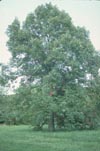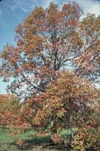Home >
Quercus michauxii,
Swamp Chestnut Oak
Swamp Chestnut Oak is another one of the several oaks that tolerate wet soil, yet tolerate dry sites well. In order to create the strongest tree, the central trunk should dominate the canopy. Competing limbs should be removed, or shortened, when the tree is young. Best growth is attained in acid soil. Trees in hardiness zone 9B require regular irrigation. Acorns are large and make a mess of the street and walks below the canopy.
Trees occur through north Florida south to Citrus County.
Swamp Chestnut Oak should be grown in full sun on almost any soil, tolerating poorly drained sites for a short period. Although native to bottomlands and slopes and despite its common name, trees perform nicely along streets and in parking lots with no irrigation once trees are established. Acorns on this oak are especially good for wildlife. This is a great tree for streets and shade with its upright, spreading habit.
The tree grows upright until middle age when the canopy spreads out forming a rounded outline. This makes the tree well suited for street tree planting. Be sure to subordinate stems that compete with the leader for the first 20 years or so after planting. Trees are very tolerant of urban conditions and have survived and grow well along streets. Trees compartmentalize decay fairly well meaning that once injured, the tree has the ability slow or stop the spread of decay.
Wood
weighs about 67 pounds per cubic foot. Oak wood is considered ring porous
to semi-ring porous. Oaks serve as larvae host plants for the brown duskywing
butterfly (Erynnis horatius) and the gray hairstreak (Strymon
melinus).
National champion is 200 x 148 feet in Alabama.





